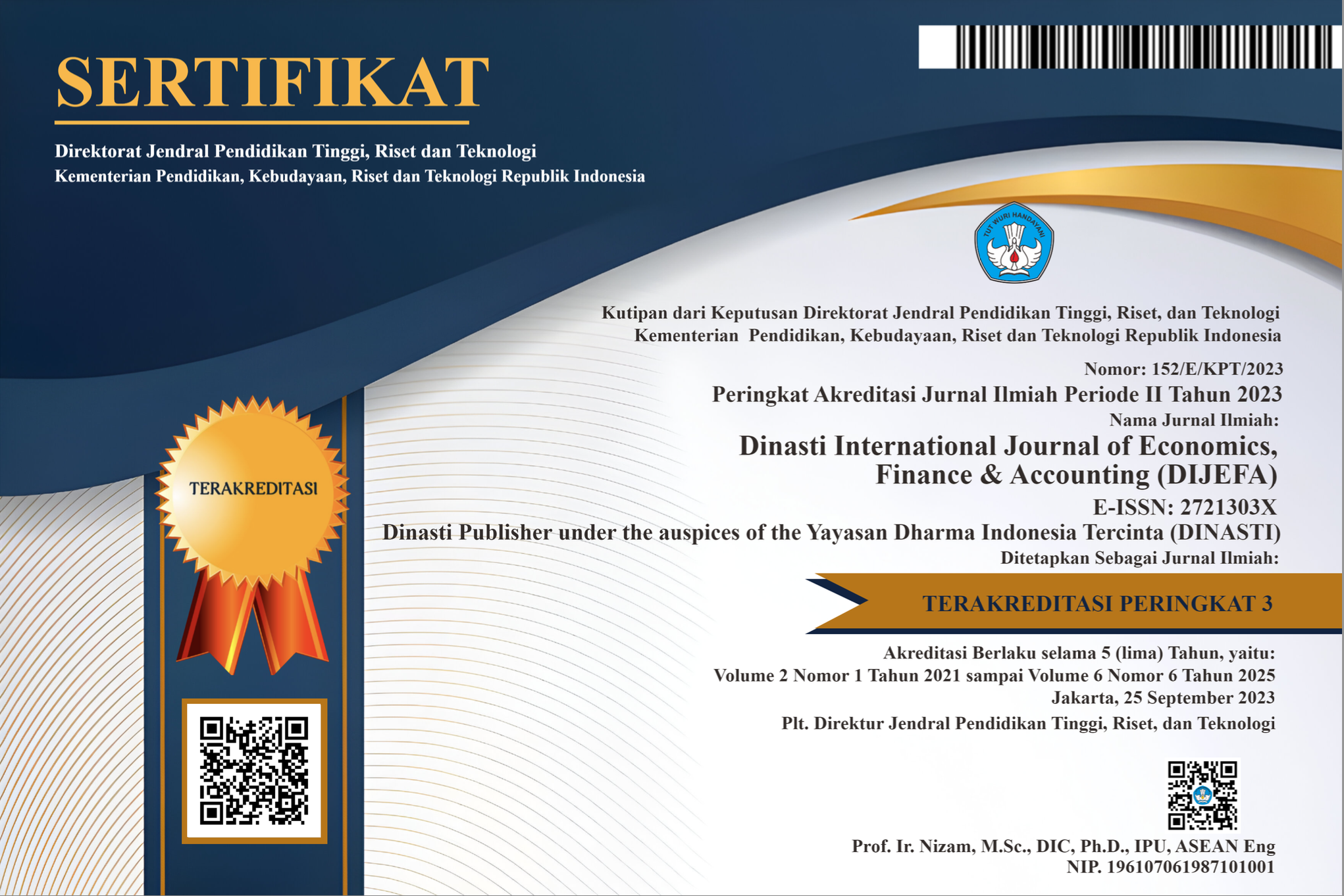Purchase Intention of Green Beauty Product: Does Perceived Value Matter?
DOI:
https://doi.org/10.38035/dijefa.v6i1.3989Keywords:
Perceived Value, Purchase Intention, SustainabilityAbstract
The increasing environmental impact of the cosmetics industry has led to a growing consumer interest in eco-friendly products. This study examines the purchase intentions of Indonesian millennials for green beauty products, focusing on the role of perceived values, which are functional, social, and emotional. Using a quantitative approach, data were collected from 190 millennials through an online survey and analyzed using SPSS 24. The results reveal that functional value, social value, and emotional value positively and significantly influence purchase intention. These findings underscore the importance of emphasizing product functionality, social contributions, and emotional engagement in marketing strategies. This research provides valuable insights for businesses seeking to align with sustainability goals and cater to environmentally conscious consumers. Future studies are encouraged to explore additional factors influencing green purchase behavior across diverse demographics and regions.
References
Amin, S., & Tarun, M. T. (2021). Effect of consumption values on customers’ green purchase intention: a mediating role of green trust. Social Responsibility Journal, 17(8), 1320–1336. https://doi.org/10.1108/SRJ-05-2020-0191
Awuni, J. A., & Du, J. (2016). Sustainable Consumption in Chinese Cities: Green Purchasing Intentions of Young Adults Based on the Theory of Consumption Values. Sustainable Development, 24(2), 124–135. https://doi.org/10.1002/sd.1613
Bei, L.-T., & Simpson, E. M. (1955). The Determinants of Consumers’ Purchase Decisions for Recycled Products: An Application of Acquisition-Transaction Utility Theory. Advances in Consumer Research, 22(1), 257.
Biswas, A., & Roy, M. (2015). Green products: An exploratory study on the consumer behaviour in emerging economies of the East. Journal of Cleaner Production, 87(1), 463–468. https://doi.org/10.1016/j.jclepro.2014.09.075
Boztepe, A. (2012). Green Marketing and Its Impact on Consumer Buying Behavior (Issue 1).
Canil, J., Karpavi?ius, S., & Yu, C. F. (2021). TMT gender diversity: implications for corporate tournaments and innovation. European Journal of Finance, 27(17), 1765–1790. https://doi.org/10.1080/1351847X.2021.1913430
Chamorro, A., Rubio, S., & Miranda, F. J. (2009). Characteristics of research on green marketing. Business Strategy and the Environment, 18(4), 223–239. https://doi.org/10.1002/bse.571
Ganak, J., Chen, Y., Liang, D., Liu, H., & Chi, T. (2020). Understanding US millennials’ perceived values of denim apparel recycling: insights for brands and retailers. International Journal of Sustainable Society, 12(4), 267. https://doi.org/10.1504/ijssoc.2020.10034648
Garnier Sustainability Team, G. S. T. (2020). GARNIER BERKOMITMEN MENUJU GREEN BEAUTY. Garnier.Co.Id.
Garnier Sustainability Team, G. S. T. (2022). Lebih banyak Formula Ramah Lingkungan. Garnier.Co.Id.
Hoe, J. T. T., Dastane, O., & Selvaraj, K. (2018). Predicting Consumer Perception and Its Impact on Purchase Intention for Residential Property Market. Journal of Technology Management and Business, 5(2), 59–77. https://doi.org/10.30880/jtmb.2018.05.02.007
Jiang, Y., Balaji, M. S., & Jha, S. (2019). Together we tango: Value facilitation and customer participation in Airbnb. International Journal of Hospitality Management, 82, 169–180. https://doi.org/10.1016/j.ijhm.2019.05.004
Kalafatis, S. P., Pollard, M., East, R., & Tsogas, M. H. (1999). Green marketing and Ajzen’s theory of planned behaviour: A cross-market examination. Journal of Consumer Marketing, 16(5), 441–460. https://doi.org/10.1108/07363769910289550
Kotler, P. (2011). Philip Kotler’s contributions to marketing theory and practice. Review of Marketing Research, 8, 87–120. https://doi.org/10.1108/S1548-6435(2011)0000008007
Lee, K. (2008). Opportunities for green marketing: Young consumers. Marketing Intelligence and Planning, 26(6), 573–586. https://doi.org/10.1108/02634500810902839
Lin, P. C., & Huang, Y. H. (2012). The influence factors on choice behavior regarding green products based on the theory of consumption values. Journal of Cleaner Production, 22(1), 11–18. https://doi.org/10.1016/j.jclepro.2011.10.002
Moosa, A., & He, F. (2022). The relationship between green operation and sustainable quality performance: the mediation role of environmental technology. Journal of Environmental Planning and Management, 65(8), 1414–1435. https://doi.org/10.1080/09640568.2021.1931823
Naffaturrahmah, M. (2023). FAKTOR PENENTU YANG MEMENGARUHI NIAT BELI KONSUMEN PADA ONLINE FLASH SALE DI SHOPEE.
Sánchez-Fernández, R., & Iniesta-Bonillo, M. Á. (2007). The concept of perceived value: A systematic review of the research. Marketing Theory, 7(4), 427–451. https://doi.org/10.1177/1470593107083165
Sheth, J. N., Newman, B. I., & Gross, B. L. (1991). Why We Buy What We Buy: A Theory of Consumption Values (Vol. 22).
Straughan, R. D., & Roberts, J. A. (1999). Environmental segmentation alternatives: A look at green consumer behavior in the new millennium. Journal of Consumer Marketing, 16(6), 558–575. https://doi.org/10.1108/07363769910297506
Sweeney, J. C., & Soutar, G. N. (2001). Consumer perceived value: The development of a multiple item scale. https://doi.org/10.1016/S0022-4359(01)00041-0
Watanabe, E. A. de M., Alfinito, S., Curvelo, I. C. G., & Hamza, K. M. (2020). Perceived value, trust and purchase intention of organic food: a study with Brazilian consumers. British Food Journal, 122(4), 1070–1184. https://doi.org/10.1108/BFJ-05-2019-0363
Downloads
Published
How to Cite
Issue
Section
License
Copyright (c) 2025 Windarko Windarko, Cynthia Sari Dewi, Djano Lastro, Hanifah Pagar Alam, Felicia Felicia

This work is licensed under a Creative Commons Attribution 4.0 International License.
Authors who publish their manuscripts in this journal agree to the following conditions:
- The copyright on each article belongs to the author(s).
- The author acknowledges that the Dinasti International Journal of Economics, Finance & Accounting (DIJEFA) has the right to be the first to publish with a Creative Commons Attribution 4.0 International license (Attribution 4.0 International (CC BY 4.0).
- Authors can submit articles separately, arrange for the non-exclusive distribution of manuscripts that have been published in this journal into other versions (e.g., sent to the author's institutional repository, publication into books, etc.), by acknowledging that the manuscript has been published for the first time in the Dinasti International Journal of Economics, Finance & Accounting (DIJEFA).


























































